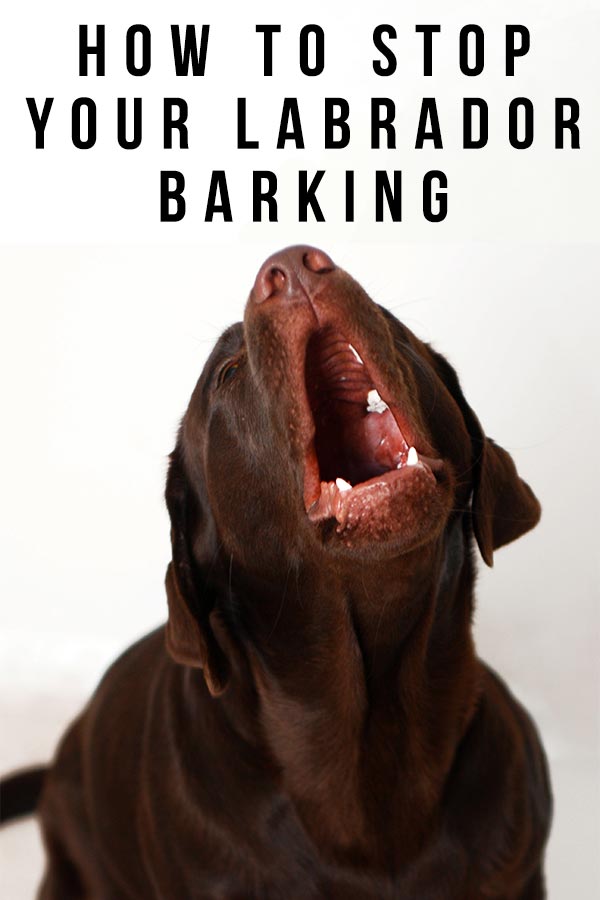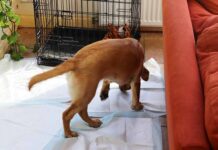Dealing with your Labrador barking can be very stressful. But there is a way to help reduce the noise that really works. We call the technique Click For Quiet, and I use it to reduce noise by reinforcing silence.
Why is my Labrador barking?
When a new puppy arrives in his new home, he has to contend with a whole new world. He probably feels quite lost at first, especially when you are not there. It can’t be easy, and many puppies cry a little when left alone or placed in a crate. Sometimes simply leaving the puppy to ‘cry it out’ can be the best solution. But some puppies get terribly distressed and wind themselves up into quite a state. Added to which, howling at night may not go down too well with your neighbors!
A noisy puppy can also be one of those problems that creeps up on you without you noticing. One day he grumbles a little in his crate, and a few days later he is whining and yapping to be let out.
Teach your puppy to love silence
This technique will help you teach your puppy that silence is a good thing. There is no force involved and it works quite rapidly to resolve crying in small puppies. The example below shows you how to teach a puppy not to cry when he cannot see you.
Equipment for teaching click for quiet
To stop your Labrador barking you will need a clicker, and some nice juicy little chunks of roast chicken, sausage or beef. Cut the chunks very small so that they are not much bigger than a pea. The reason for using a clicker is that initially, the gaps in your puppy’s crying may be very brief. A clicker is a nice accurate way to mark and identify those gaps, so that your puppy understands what he is being rewarded for.
You will need to place the puppy somewhere that enables you to close one of the doors in your house with the puppy in his crate on one side and you on the other. You can put him in his crate if you need to.
Exercise 1 – Click for Quiet
- Step out of the room that the puppy is in and close the door
- Count to three
- If the puppy has remained quiet throughout the thee seconds press the clicker
- Return immediately to the puppy and give him a tiny piece of roast meat
- Repeat twice more from step 1 then move on to exercise 3
- If the puppy cries before you get to three, be ready to press the clicker as soon as he pauses for breath. Don’t wait for a long pause, just a second will do.
- Press that clicker immediately the puppy pauses for breath and before he starts crying again.
- Return immediately to him EVEN if he is now crying again.
- Reward him with a tiny piece of meat
- Repeat from step 1 until the puppy regularly pauses in his crying within a short time of starting then move on to exercise 2
Exercise 2 – Longer Silences
In this exercise we will build up the length of time that your puppy will remain silent after he has stopped crying. We are teaching the puppy that to become silent and to remain silent, is rewarding.
- Step out of the room that the puppy is in and close the door
- Count to three
- If the puppy has remained quiet throughout the three seconds press the clicker
- Return immediately to the puppy and give him a tiny piece of roast meat
- Repeat twice more from step 1 then move on to exercise 3
- If the puppy cries before you get to five, be ready to press the clicker
- As soon as he pauses for breath start counting in your head. Count one thousand two thousand. Don’t click for very short pauses, but don’t wait for a long pause, just two seconds will do.
- Press that clicker immediately you get to two thousand.
- Return immediately to him EVEN if he is now crying again.
- Repeat from step 1 until the puppy regularly pauses for two seconds, within a short time of starting to cry
Your next task is to increase that pause to three seconds, then to five, then seven, then ten. And so on. Gradually lengthen those pauses. Check out the tip below for the most effective way to lengthen pauses without a breakdown in your new behavior.
If at any time the puppy starts to slip back again, just go back a step or two and move forward more slowly.
The next exercise is for puppies that are successful in not crying at all for the three seconds after you first leave them alone.
Exercise 3 – Quiet and Alone
- Step out of the room that the puppy is in and close the door
- Count to five
- If the puppy has remained quiet throughout the full five seconds press the clicker
- Return immediately to the puppy and give him a tiny piece of roast meat
- Repeat twice more from step then
- Step out of the room that the puppy is in and close the door
- Count to seven and go to step 3
You can see where we are going with this. Build up the amount of time your puppy can remain quiet for after you have left the room, in exactly the same way as you build up the pauses in his crying.
Mix up the duration!
If you keep adding duration steadily you will soon reach a point where your puppy ‘cracks’ and starts to cry. You will then have to ‘back -up’ and return to a simpler exercise. To avoid this, simply mix and match the duration of your absences as you go. In each session, sandwich the longest absence, in between some shorter ones. For example, if all goes well and the puppy does not cry when you leave the room very briefly, in the second session you might leave the puppy for the following
- three seconds
- then five
- then two
- then seven
- then three again
Build up gradually
By the time you get to the tenth session, you might leave him for:
- twenty seconds
- ten seconds
- forty-five seconds
- twenty seconds
- then five seconds
It may not seem like much but you have actually made a break through. You have taught your puppy to chose to remain silent for a few seconds. Now all you need to do is build on that in nice easy stages so that your puppy cannot fail.
Slow and steady
Don’t rush it. Be glad of your three seconds. Celebrate it, and cherish it. If you can teach a puppy to be quiet for three seconds, you can teach him to be quiet for three minutes, and so on. It is a process. Work carefully and you will get there.
Teaching older dogs to be quiet
The clicker for quiet technique works well dealing with an older Labrador barking too. Older dogs have learned that crying or barking gets them attention. Some have simply learned to enjoy the sound of their own voice. Either way, teaching them that silence is rewarding, is the way to go.
Related Articles
The Labrador Site Founder
Pippa Mattinson is the best selling author of The Happy Puppy Handbook, the Labrador Handbook, Choosing The Perfect Puppy, and Total Recall.
She is also the founder of the Gundog Trust and the Dogsnet Online Training Program
Pippa's online training courses were launched in 2019 and you can find the latest course dates on the Dogsnet website



















My 13 week old lab pup is finally quiet and sleeping all night once i moved a crate into the bedroom. She did not settle down and sleep well with the one in the family room at the other end of the house(kind of far away form the bedrooms). So we are happy with this.
Now, when i put her in the family room crate during the day, she is quiet for about an hour and then wakes and starts crying/yipping/howling. Will the method you have outlined above work at his point? I am home a lot, but I do need to run errands that are longer than 1 hour!! Thank you in advance for your response
I have gained a lot of information from your facebook posts-thanks!!